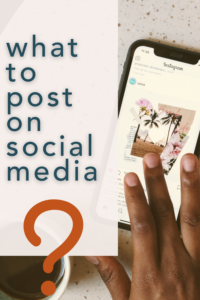What to post on social media?
I’ve been using social media for business since 2011.
I’ve been blogging since 2011, as well, and my experience is pretty wide. I’m an online entrepreneur, and I’ve been doing that for a long time, but I’ve also done social media for local companies, for real estate, for a Bible college, for a web-based service company, for individuals, and of course for myself.

Table of Contents
ToggleCommon Social Media Mistakes
There’s a lot of things I see that people do, especially early on in their business, that are causing them not to have any progress posting on social media. Or, it’s causing them to be insecure about how they’re posting on social media.
Mistake #1: No Purpose
One of the biggest things that trips people up in deciding what to post on social media is not having a clear purpose for their content.
Back when I was working in corporate, we would just come up with a content calendar. Our posts were just kind of random – holiday related, or showing people behind the scenes, even though our people didn’t care about behind the scenes.
So instead, we decided to really focus on themes for each day. But, every single post had a purpose.
For example, motivation Monday is great! But, if you don’t have a business purpose for sharing something about motivation Monday, then you’re just posting to post.
It’s just not that interesting for your avatar.
And, it’s not going to do anything for you in the end. So for our motivation Monday, we decided to promote people who were local and related to our business that we could recommend because we trusted them. We used it as a promotional opportunity, because we would write a post promoting them and they would share that post about us from our page.
So, the purpose of that was networking.
We were writing these Monday motivational posts about other companies who worked in our industry. They didn’t compete with us, and they’re going to promote us because we’re promoting them. So even though it was a motivational Monday post, it had a business purpose of networking.
Every. Single. Post. needs to have some kind of business purpose behind it.
Now, it doesn’t always have to be selling.
A lot of my calls to action are for engagement. When you guys comment and react to things, more of my posts are seen in the algorithms. Same goes for you: more of your posts will be seen in the algorithm if your audience is engaging with it.
That’s why I do threads where I do free coaching in the threads. I know it will help my post to be seen by more people, because more people are commenting on them.
Mistake #2: Not Getting to the Point
The most common application of this is when people say, “Hey guys, I wrote a new blog post.” And then they just share the link to the blog post.
Nobody knows why they should read that blog post. You are going to have SOME people who inherently just care about you because they know you and want to click on that blog post because you wrote it.
But you’re probably not going to have enough of those people to move the needle. So if you want MORE people to click on your new blog post, you need to give them a reason why they should click on it.
You need to help them understand what’s in it for them.
So even if I’m just sharing two to four sentences about a new blog post that I wrote, if I’m going to share a new blog post on social media, I always give context first. I don’t just say, “Hey guys, I wrote a new blog post here’s the link.”
One way to get to the point is to ask a question that would help them to understand what’s in that post, and how it relates to what they’re struggling with.
Mistake #3: Posting Just to Post
People think, “I haven’t posted in a while, I need to post.”
We’re going to talk about this in a minute with mindset, but your posts need to be somewhat inspired. If all you’re doing is just educating and it’s kind of dry, people need to be drawn in by your energy and your interest in it.
When I write a post just to post, those are almost always my lower engagement posts. Every now and then I’ll have something I’m really passionate about and I’ll write about it, and the engagement won’t be that great. But for the most part, when I’m really excited or fired up about something or even upset about something and I post about it, those are my posts that perform the best typically, regardless of algorithm changes.
The Mindset of Social Media
When I first started thinking about what I wanted to include in this training, initially, I wasn’t going to talk about mindset at all.
I was thinking it wasn’t something that I struggled with that much, but the more I was outlining what I wanted to teach today, the more I realized that I really struggle with second guessing what I actually want to write about or post on social media.
We can all tend to worry about things like:
- Am I posting at the wrong time?
- Should I wait to post this because I just posted like five hours ago?
- Should I spread out my posts more?
- Is this too selfish?
- Is this too (fill in the blank)
- Am I bragging too much in this post?
- Am I giving away too much information for free?
There’s all these doubts that come up about what you’re posting.
And if you are a perfectionist, then you’re going to struggle with this even more. There are two huge, massive, giant tips that I have that you can probably apply to a lot of other areas of your business. Thinking about incorporating video with your marketing? Read about video for beginners.
The first one is, if you feel inspired to share something, you need to trust that there’s somebody out there that needs to hear it.
And I don’t want to get too woo-woo about this, but I really believe like if you are in my world, if you’re in my community, that you probably care about people.
Even if you’re not very woo-woo, it’s fair to say that when you feel inspired to share something, it’s probably because somebody needs to hear it. And it doesn’t matter if one person likes the post, or if 100,000 people like the post. That one person is who needed to hear it.
And you can consider it divine, or you can consider it just practical application and needing to help people, but you’re not just sharing something for the sake of sharing it.
Right?
I’m not in this business because I want to become famous. I wouldn’t mind being a little more visible, but that’s not why I’m in this. I’m in this because I remember the pain of wanting to do something and just not knowing how to do it and not being able to find the resources to help me.
You’re in the business that you’re in because you want to help people, and you do want to make money. There’s lots of ways to make money, but making money in a way that is fun for you, and that is enjoyable, and then actually helps people – that’s really what makes it more fun.
Hopefully knowing that you’re doing this from a selfless place will help you to get over being insecure. It’s not about you. Your business is not about you, it’s about helping someone.
The second part of the mindset around social media is detachment.
Always have a slight attitude of detachment or neutrality from things – of trusting that if you just keep going, things will work out. That is really, really important.
The two things you need to remember about detachment are:
- there’s always another social media post, and
- there’s always another algorithm change.
I did a training in my group over a year ago, and somebody was really freaked out about the Instagram algorithm.
Go here to learn more about visibility.
And I was like, “It doesn’t matter.”
And honestly, on Instagram, the same few things that were taught three years ago, which is a long time in internet years, are the same things that still work on Instagram. Engage with hashtags that are high value, but not too high volume, follow people who are like you, engage in the hashtags before and after you post, post consistently, use every single feature. There’s a mini Instagram training for you.
Massive algorithm changes happen. Sometimes they will benefit you, and sometimes they will be to your detriment, but for the most part, best practices on Instagram are really similar to what they were a few years ago.
That post that you put up that you felt so fired up about? That nobody commented on? It doesn’t matter.
Because that post will still inspire, and you can re-swizzle it. You can try it in a different form later on.
More Social Media Tips
1. You don’t always have to save your good ideas for your content calendar.
A lot of times in the past, I would hesitate to post something because I had just posted something in the last few hours.
What I’ve found is when I’m feeling really inspired about something, it usually performs better if I just go ahead and post it anyway. Because every single day you can have new ideas and new inspiration.
There’s some times on Instagram when I post a whole bunch. I post every single day, maybe multiple times per day.
And, there’s times where I space out a little bit more. But what I do on Instagram has been working for me, as I’m consistent, generally speaking. I use a lot of the Instagram features – stories, posts, IGTV, Lives, and I have someone help me with Instagram engagement with the hashtags.
You don’t have to always save things to schedule them. If you really want to post it, go ahead and post it.
2. A good post is a good post.
This idea was inspired by Sarah Dan. If you guys don’t know her, she’s amazing.
If I post something six months ago or a year ago, and you guys really love it and engage with it, I will probably end up repurposing that post.
I’ve never had anyone notice because there’s a long span of time in between. And, the people who are the most active in my community tend to cycle through. That’s just a normal process – there are some people who’ve been really visible in my community for over two years now, but the majority of people tend to cycle through, where they come into my world and they’re super engaged, and they step out and they’re doing other things, and they might come in and come out again.
So it’s totally fine to repurpose your content down the road.
That’s why I have all my posts now saved in Google Drive in different folders by topic. If I don’t have time to write, or if I’m not feeling that inspired, then I’ll just go from that folder and I’ll say, “I really want to talk about traffic today. I had a client who had some success, are there past tips that I can share?” And I’ll just go in my folder, in the traffic folder and find a tip for that.
3. Don’t overthink your posts.
Always have an outward view of things; always make sure that you’re helping people. You always need to make sure that you have a business purpose, and at the same time, don’t overthink things. There’s always another post. There’s no place for perfectionism in social media.
4. Always have a call to action.
Always make sure that you have some kind of call to action, even if the call to action is just conversation.
5. Make sure to keep your content calendar simple.
I think one of the mistakes that I’ve personally done in the past is okay, Monday is this theme, Tuesday is this theme, Wednesday is this theme, Thursday is this theme, Friday is this theme and Saturday is this theme, Sunday, we take a day off.
Now, because I really have just a small number of things that I’m selling for my coaching business, I just gear my content around whatever my focus is for that month.
But for you, if you’re a content creator or an influencer, I would choose a theme per week or every other week. So, if if you are posting blog posts consistently, then I would say that your blog post should just be the foundation of your content.
So every week I’m going to share that I have a new blog post and I’ll do long form content. I’ll share an image with a quote from the blog post. I’ll share a few other posts all related to that blog post. Don’t overthink it, and just keep showing up no matter what.
What should you post on social media? Whatever the hell you want.
It’s really easy to get hung up on the practical side of what to post, when to post, how to post, what are my content pillars?
None of that matters.
You are your brand, your people are here for you.
You’re going to have some core topics that you’re talking about. In my coaching business, I’m talking about traffic, blogging, course content, creation, visibility, mindset, what to create, how to sell it, what to price it for.
I’m talking about basically creating things to sell and teaching how to sell it, whether you’re a blogger or an influencer.
And if you don’t feel like posting, then I would probably take a look at that.
If I never feel like posting, and if I just never want to use social media:
- Am I in the wrong niche?
- Am I talking about the wrong things?
- Do I need to maybe do video instead of writing?
- Do I need to maybe share more graphics instead of video?
If you never ever want to do it, I would think about the energy behind why.
Maybe it’s something that you need to outsource.
Maybe it’s like Sarah Dan, just to use her as an example again. She was launching a program, and when you’re launching something and you have an email list, you’re usually sending out emails at least once a day.
And she, during this particular launch, she did a series where she would send an email, but the email would have a link to an audio file where she just talked about what she wanted to talk about that day, related to her launch.
I’d never seen anybody do that before – she didn’t feel like writing emails, so she didn’t. She linked to audio, because it felt easy for her in the moment.
So if you hate social media all the time, and you never know what to post, and you feel overwhelmed by it, or you’re just not enjoying it, then make it work for you.
You have to show up online somewhere in order to sell things online.
Best Practice for Post Content
One good approach to writing your content is to open with a story: about clients, about yourself, or even a public example. You don’t always have to share a story, but I always open with some kind of introduction to draw people in.
And then I’ll say something along the lines of: “Here’s three tips to address this.”
Or I’ll say, “Here’s the number one tip to address this, and here’s an example of what that looks like.”
You can either give a couple of tips, or you can give one tip, and then share some more description or context around it.
But remember, your social media posts don’t always have to be long form. Some of my best performing social media posts are one to two sentences. Just because you want to post on social media everyday doesn’t mean you’re happy writing a whole additional blog post.
Repurposing Content
You can really stretch your content by repurposing it on different platforms.
For example, this week I wrote an email and four social media posts, and now I’m going live on my business page.
Instead of going live on Instagram today, I’m recording a vertical video on my phone, because I want a high quality version of this live so that I can make a bunch of little videos with it. So from a 30-minute video I’m going to get maybe five short form videos out of this one vertical video.
That’ll give me five Reels, five TikTok videos, and maybe even five Facebook videos.
In addition, from my outline for this post, I have at least 10 good one line quotes. That’s 10 one line quotes, which will be 10 short form videos. You get the idea. But if you’re putting out a blog post or a live video like what I’m doing now, that should be repurposed in as many ways as you can think of.
Now, I want to give you a caveat: posting more and posting to more places does not necessarily mean that you’re going to grow faster or make more money.
More is not always more. (Less isn’t always more either.) If posting on all these different platforms is making you not create more content, not create great content, not put your heart into your content, then stop.
Choose one platform to obsess over for traffic and one platform to obsess over for trust.
Those could be the same platforms, but they don’t have to be. For example, I use Reels, then I’m using TikTok, and I use Facebook. I did not do that for years in my business. And when I did that early on, it did not help me, it did not make me any more money.
So, if Instagram is where you’re building an audience, then Instagram could be traffic and trust. If you have a blog, you’re probably going to be doing Pinterest early on, depending on your niche. Or, it could be SEO instead, and then choose one other platform to build trust, because no one’s having conversations on Pinterest that are meaningful besides people sending each other spammy pins all day.
“Is it too much to post on every single one of your social media accounts, plus a blog on your website?”
When deciding what to post on social media, I would caution you against scheduling posts on all your platforms all at one time.
I don’t think there’s any problem with posting to every single platform every single day. I would just try to intuitively separate how you do that.
NEED MORE SUPPORT?
If you need some help on your way to becoming a successful blogger, feel free to drop me a comment below.
And, if you are interested in working with me, book a chat at: https://alisonreeves.co/strategy-call






